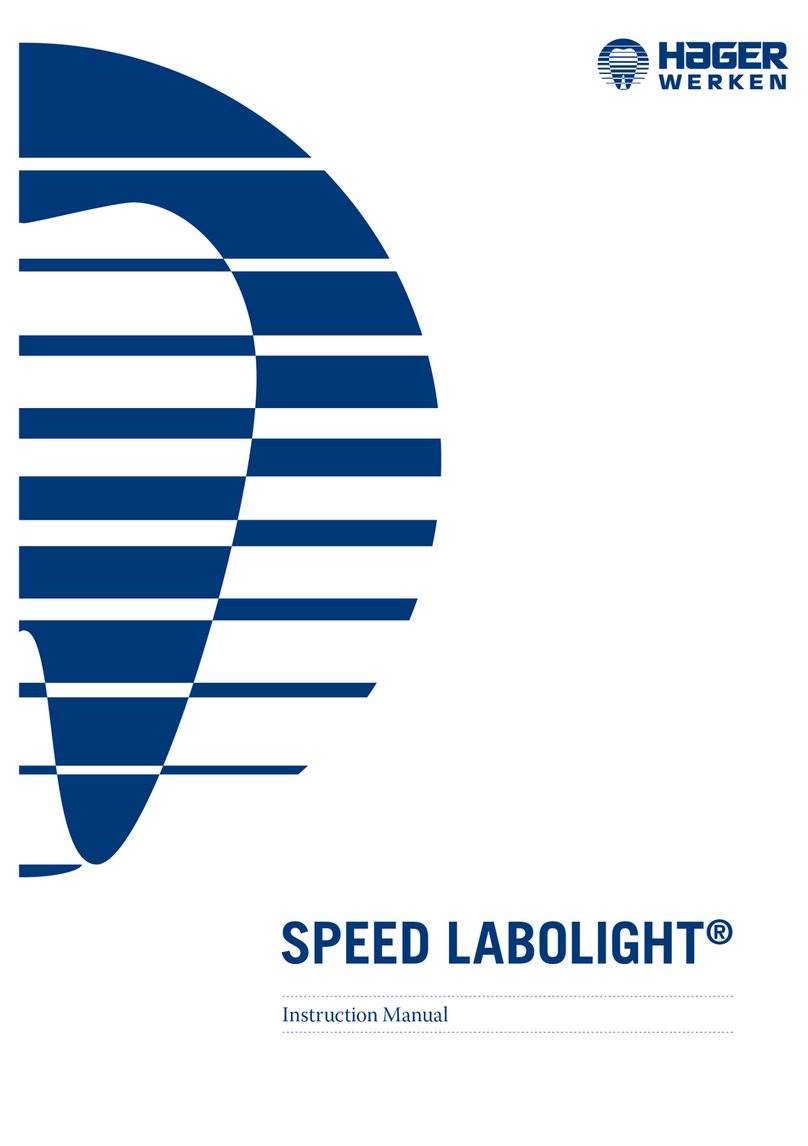
3
benutzen. Stellen Sie sicher, dass das Objekt aufrecht nahe den Lampen steht.
•SchließenSiedieTür
•DrückenSiedenKnopf“3”(Menü)undwählenSie:1:DiePolymerisationszeitinMinuten.Um
den ausgewählten Wert zu verändern, drücken Sie Knopf “4”. Wenn der gewählte Wert im Dis-
play erscheint, drücken Sie erneut Knopf “3” (Menü), um den Wert zu bestätigen und fahren wie
folgt fort.
2: Die Nachkühlphase in Minuten, d.h. die Zeit, die der Ventilator nach Beendigung des Vor-
gangs in Betrieb bleiben soll (minimum 1 Minute). Wählen Sie die gewünschte Zeit mit den
Knöpfen “4” aus und drücken dann erneut Knopf “3”, um den Wert zu bestätigen. Danach fahren
Sie wie folgt fort.
3: Wählen Sie aus, ob Sie einen Polymerisationsvorgang mit oder ohne Halogenlampe benöti
gen (1=NEIN; 2=JA). Um von Position 1 auf 2 zu wechseln, benutzen Sie Knopf “4”. Drücken Sie
erneut Knopf “3”, um den Programmiervorgang zu beenden.
Jetzt ist das Gerät bereit, den Polymerisationsvorgang durchzuführen.
•DrückenSieKnopf“2”(START)
•StellenSiesicher,dassdasObjektdieLampennichtberührt.
Warten Sie das Ende des Polymerisationsvorgangs ab, sowie auch die Endkühlphase.
•ÖffnensiedieTür,undholenSiedasObjektausdemGerät.
•ImFalleinerEntnahmewährenddesPolymerisationsvorgangsdrückenSieKnopf“2”(START)
und öffnen die Tür manuell.
•Wenn die Tür während eines Polymerisationsvorgangs geöffnet wird, ohne der oben aufge-
führten Anleitung Folge zu leisten, wird der Vorgang abgebrochen, aber das Gerät wird dennoch
die voreingestellte Abkühlphase durchführen.
3.b Spracheinstellung:
Taste „-“ drücken und Gerät einschalten. Im Display erscheint die eingestellte Sprache. Um
diese zu wechseln die Taste „-“ solange drücken bis die gewünschte Sprache erscheint. Es stehen
die Sprachen Deutsch, Italienisch, Englisch und Französisch zu Verfügung.
4. Lebensdauer und Austausch der Lampen:
1. Die Lebensdauer der Lampen beträgt ungefähr 1000 Betriebsstunden. Das Gerät ist mit
einem Zeitzähler ausgestattet, welcher die Anzahl der Betriebsstunden anzeigt. Um den
Zeitzähler an zuzeigen und die Anzahl der Betriebsstunden zu überprüfen, führen Sie Fol-
gendes durch:
•SchaltenSiedasGerätaus.
•WährendSiedenKnopf“+”gedrückthalten,schaltenSiedasGerätwiederein.AufdemDisplay
erscheint die Anzahl der Betriebsstunden in Stunden und Minuten.
•SchaltenSiedasGeräterneutaus,bevorSieeinenneuenPolymerisationsvorgangdurchführen.
2. Wenn die Lampen eine Betriebszeit von 1000 Stunden erreicht haben, müssen sie ausgetauscht
werden. Nachdem sie ausgetauscht wurden, muss der Zeitzähler wieder zurückgestellt werden.
Dieses geschieht wie folgt:
•SchaltenSiedasGerätaus.
•Taste„+“und„-“drückenundGeräteinschalten(Laufzeitwirdangezeigt).
•HaltenSiedieTasten„+“und„-“fürca.30SekundenbisdieZeitaufNullgestelltist.
•SchaltenSiedasGeräterneutaus.




























